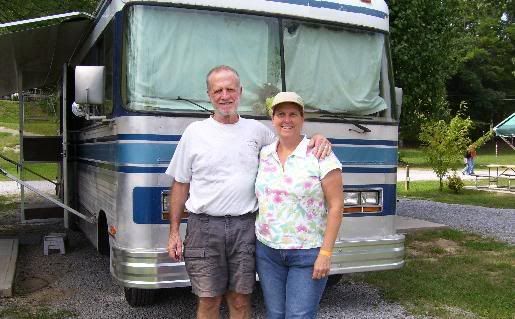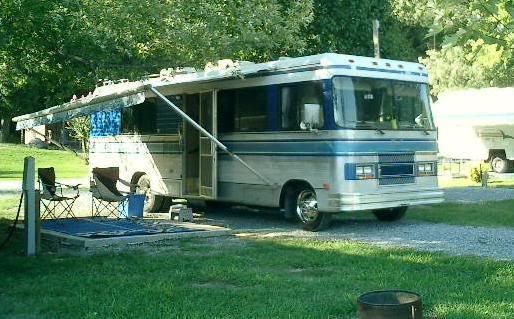Go to...  | Start A New Topic  | Search  | Notify  | Tools  | Reply To This Topic  |  |
 6/12 6/12Formally known as "Humbojb"  |
The hoses coming from the heater box located in the cab, are cut. I've asked Doorman to look at his '76 to see how they are run, but thought I'd ask the group as well. I've looked at some pics on the internet but still am not sure. Looks like one of the hoses goes to the water pump and the other someplace towards the front of the intake manifold. Any help would be appreciated. The hoses from the hot water heater were also cut and I don't have any idea where they went or if they were part of the heater hoses. Thanks Jim
| |||||||||||
|
 6/12 6/12Formally known as "Humbojb"  |
There is a hose, probably 1/2" ID, going from a nipple on the passenger side of the intake manifold to the left(looking at the engine from the front) of the big hose from the radiator, to a nipple on the upper left side of the radiator near the top. I'm thinking that whoever cut the heater hoses, used this loop to bypass the heater entirely. What do you all think? I've looked a manual for a 1974 Chevy truck including the G series vans, and it says that the system has no water valve so the water circulation keeps the core hot at all times. Someone may have thought that the heat in the cab was due to that and cut the whole thing off. Which was stupid since the temp of the air is dependent on the ratio of heated to unheated air. Again, any comments/suggestions would be appreciated.
| ||||||||||||
|
Official Barth Junkie |
that sounds like a bypass indeed. Hook up through heater and it should work. 9708-M0037-37MM-01 "98" Monarch 37 Spartan MM, 6 spd Allison Cummins 8.3 325+ hp | |||
|
 3/23 3/23 |
It is unbelievable what folks, have done to these units. Wait to I show you all the fuse box conversion Rube Goldberg did to my unit. I love it and intend to keep it as I find out what non-connected wires do I will have to add to the system. My axillary heater and water heater hoses were also revamped, removing the rear heater, I did my own bit of Goldberg making a home made heater box to use engine heat in the rear of the coach, yet to see if it makes enough heat. The front chassis heater does not function properly, so I really need the rear heat. There is a faucet shut off valve in that heater line, I guess they tried to shut off flow to the hot water heater. The beauty was a room air conditioner installed in the rear window opening. Wish I knew what they did with the window. I love the history. 1971 24 ft Barth Continental P30 chassis 350 engine | |||
|
Official Barth Junkie |
You have a great attitude towards finding these "creative surprises." It is amazing to me what a mystery electricity can be to some, and the absolutely confusing attempts they make to harness it. I can't tell you how many times I have spent hours trying to figure out what was done, why it was done, and how to undo/correct it. Usually end up starting over, rip out all the old and just rewire it properly. The aux cab heat should work well. I made one for the 86 and it heats the whole front of the coach. Good luck with your projects, keep up the good attitude. 9708-M0037-37MM-01 "98" Monarch 37 Spartan MM, 6 spd Allison Cummins 8.3 325+ hp | |||
|
 6/12 6/12Formally known as "Humbojb"  |
That is really part of the draw for me as well. I might complain about what 'Rube' did to hurt the old girl, but the challenge of figuring it out, fixing it, and even making it better is really a lot of fun. On my cut heater hoses, with the help of this site, I've figured it out and decided that since Chevy didn't put a water valve in their heater system for the '74 G Vans, I will. Maybe just a shut off valve one could manually close when summer rolls around.
| ||||||||||||
|
Official Barth Junkie |
Having no valve implies the loop should be able to flow (bypass). Some engines need the circulation through the heater loop, whether they are heating or not. You can get hot spots in the intake manifold if the hoses are dead ended. I had the same dilemma with the Monarch. Turns out the OEM system has full time circulation. No big deal just a bit more plumbing. Tee in a bypass loop. One valve in the bypass, one in the downstream supply line. One valve open at all times. I figure this way: If circulation was required, cutting it off could cause problms. Even if circulation was not required, letting it continuously circulate would be unlikely to cause problems. You are right about the "redo" education. I have discovered more about my 86 than I ever wanted to know but the knowlege is valuable for the peace of mind of knowing how things work and where they are. I have several friends who have offered to buy my used cars, etc, becasue they know that everything will be working. Hope it works that way when I decide to sell the Regal! Good luck with the projects. 9708-M0037-37MM-01 "98" Monarch 37 Spartan MM, 6 spd Allison Cummins 8.3 325+ hp | |||
|
 6/12 6/12Formally known as "Humbojb"  |
Steve, I understand what you mean. With no water valve, this system was designed as a flow through system. By bypassing the heater core all they did was shorten the distance by maybe 12" to 18". Overheating is not a problem. Do you see any down side to me hooking it up again? It's just 3/4" heater hose and some clamps. Guess I would have to at least partially drain the radiator, right? Jim
| ||||||||||||
|
 7/17 7/17 |
Just be ware that you might have a bad heater core. You know that chevy started building van by taking a heater core and building the rest of the van around it. 1986 31' Regal -1976 Class C 454/T400 P30 -350/T400 G30 twin cntr beds - 21' rear bath | |||
|
 6/12 6/12Formally known as "Humbojb"  |
Bad as in leaking?
| ||||||||||||
|
Official Barth Junkie |
It may have been bypassed to avoid replacing a leaky core. As Craig suggests, those cores are a nightmare to change. Just plug one side and apply suction to the other, see if it holds the suction. 9708-M0037-37MM-01 "98" Monarch 37 Spartan MM, 6 spd Allison Cummins 8.3 325+ hp | |||
|
 3/23 3/23 |
If you can't get to the lines at the radiator cut and splice where convenient. This is not as good as replacement but it is somewhat easier and if it seals against the pump ~ 40psi it will be able to hold against the <20 psi of the system. If it blows out you will not be out the coolant of the system and will also have the bypass connectors in place and it can be done in the driveway. YRMV Tim | |||
|
| Powered by Social Strata |
| Please Wait. Your request is being processed... |
|
This website is dedicated to the Barth Custom Coach, their owners and those who admire this American made, quality crafted, motor coach.
We are committed to the history, preservation and restoration of the Barth Custom Coach.
We are committed to the history, preservation and restoration of the Barth Custom Coach.



